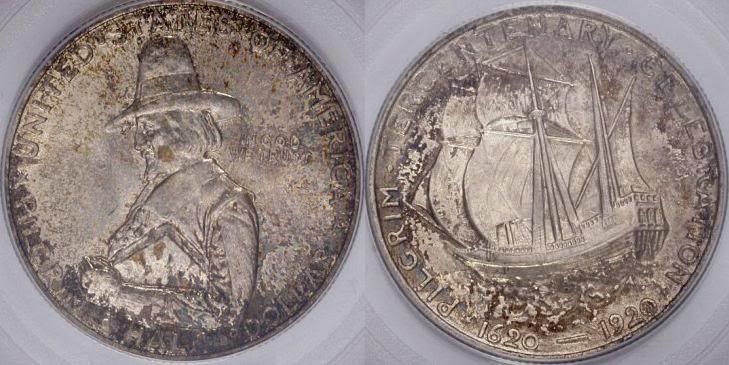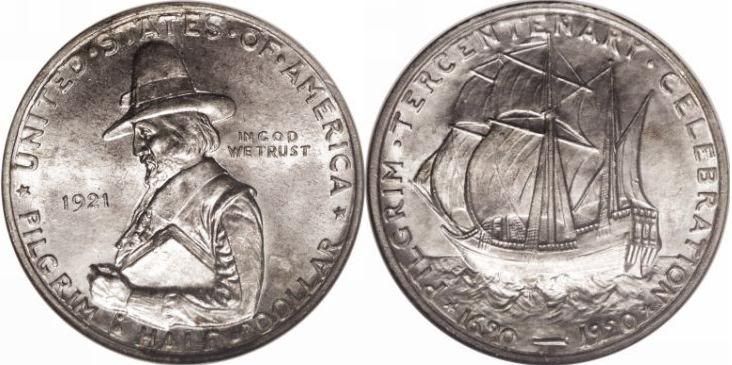Options
History Lesson: Commemorative Coins #2
 LeeG
Posts: 12,162 ✭
LeeG
Posts: 12,162 ✭
Numerous commemorative half dollars were produced to exploit collectors by requiring them to buy several or many varieties in order to keep their collections complete. This in addition to the properly dated 1920 half dollar to observe the 300th anniversary of the landing of the Pilgrims in Massachusetts, there were additional Pilgrim Tercentenary coins minted with the date 1921, to derive profits from numismatists.
Not my coins


The most extensive series began in 1926 when the Oregon Trail Memorial Association, based in New York City, issued half dollars of two varieties-Philadelphia and San Francico mint issues-to commemorate the hardships endured by the pioneers who trekked westward in the 19th century to settle the Oregon Territory. The Oregon Trail half dollars went on and on and were finally discontinued in 1939 when an act of Congress put a stop to what was perceived as flagrant abuses. Today, many collectors aspire to own a complete set of Oregon Trail half dollars consisting of 14 different varieties.

Other commemoratives issued in long sets include the 1934-1938 Boone Bicentennial, 1934-1936 Texas Centennial of Independence, 1935-1939 Arkansas Centennial, 1946-1951 Booker T. Washington, and 1951-1954 Carver-Washington coins.
Merry Christmas and so ends today's Classic Commemorative History Lesson.
0
Comments
Specializing in 1854 and 1855 large FE patterns
<
The 1921 Pilgrim was kind of a variation on the Alabama 2*2, the Missouri 2X4 and Grant with star half dollars. All of those were created to get more money out of collectors. My least favorite of that group is the Grant with star. The coin costs a fortune, the star means nothing except $$$ and usually the coin has poor eye appeal.
There were a number of other under the table deals on the early commemoratives. Two of the worst were the Hudson and the Cincinnati. A small group was able to get control of the supply of both those issues. Then they charged collectors very high prices at the time for the coins. The abuses ultimately ruined the market for early commemoratives and got Congress mad enough to end the commemorative program to boot.
<< <i>There were a number of other under the table deals on the early commemoratives. Two of the worst were the Hudson and the Cincinnati. >>
Hey hey hey, watch whay you say! One of my distant relatives is on the Hudson and someone from my family had a hand in designing it.
You're right though, sales were another story.
I asked someone why there were so many circulated, old commemoratives and was told most sales were mediocre and batches of the coins were turned loose in to circulation. Any truth?
Jerry
My golf ball marker is that POS Booker T i bought from the " MT Pinotubo hoard " from that POS 2centsin
But i knew i was falling on the grenade !
That AHOLE ripped a bunch of people and i hope i wasnt the only one that called the police !
<< <i>I'm not sure I understand one part of your text....Oregon Trail Association...."issued"....Did they have to jump through the same hoops that people would have to go through today? Like those wanting to get a commemorative for the San Francisco Mint? Petitions? Design and Congressional approval?
I asked someone why there were so many circulated, old commemoratives and was told most sales were mediocre and batches of the coins were turned loose in to circulation. Any truth?
Jerry >>
The way it worked was that a group was able to get Congress to authorize a commemorative issue. Then the group purchased the coins from the mint at face value and was free to market the coins in any way they chose. Not surprisingly there were a lot of New York state commemorative coins because they had the largest and most influential congressional delegation at that time.
The marketing of the coins sometimes resulted in scandals. A group got control of the entire issue of the Cincinnati commemoratives and sold them for $7.50 for the three piece set. Back in the 1930s $7.50 was more than a week’s wages for those who were fortunate enough to have a job. Once the coins were all issued the price drifted lower. In real dollar term (the price adjusted for inflation) it was many years before those who paid $7.50 for the Cincinnati set got their money back. AND to top it off, the coin commemorated NOTHING. There was no special event when it was issued, and Stephen Foster, who appeared on the obverse of the coin, was not a son of Cincinnati.
As early as 1925, many in Congress expressed concern over bills introduced to "...commemorate events of local and not national interest..." After extensive hearings on the "objectionable practices and abuses related to the issuance of special coins", as published in House Report No. 101, issued February 27, 1939, Congress passed legislation prohibiting "...the issuance and coinage of certain commemorative coins..." (Public Law No. 278-76th Congress - Approved August 5, 1939), which also halted the issue of all commemorative coins already approved.
With the exception of Acts signed on August 7, 1946, for the Iowa Centennial and Booker T. Washington half dollars, and an amendment to one of these in 1951 for the (George Washington) Carver-(Booker T.) Washington half dollar, no further coins were authorized. Produced from 1951 through 1954, the Carver-Washington half dollar was the last of the pre-modern commemorative coin programs.
Commemorative coin programs are created by enabling legislation enacted by Congress to honor a person, place or event. The enabling legislation dictates the coin specifications, mintages, cost considerations, and surcharge amount to be collected. A surcharge is a set amount per coin that the Mint collects and distributes to the designated recipient organization which must use the proceeds for the purpose(s) specified in the enabling legislation. Historically, the Mint has been required to pay surcharges to recipients whether or not all the Mint’s program costs were recovered and without any accountability requirements for the recipient organization. In 1996, Congress enacted legislation changing the Mint’s requirement to pay surcharges.
Compliance
Who determines the product options for commemorative coins?
The United States Mint determines the commemorative product options to offer for sale to the public based on market research, past commemorative coin purchase interest and input from the organizations that will receive surcharges from the coins.
I think that the United States Mint should produce a commemorative coin to honor a particular person or event. How can I make that happen? The United States Mint cannot make decisions to produce commemorative coins by itself. Congress must enact legislation authorizing any commemorative coins, and constituents may contact their Members of Congress to voice interest. In addition, the Citizens Coinage Advisory Committee (CCAC), an independent organization, makes recommendations to Congress in its annual report as to what people or events might be honored with commemorative coins. You may contact the CCAC at 801 9th Street, NW, Washington, DC 20220.
Tom
We'll use our hands and hearts and if we must we'll use our heads.
whether or not that's true could be it's own thread. certainly by the time the Commemorative Program reached the mid-30's spurious self-promotion and greed took over, but before that i doubt there was much intended to do anything past meeting public demand, let alone dupe collectors into adding to their sets. even Breen/Swiatek don't take any shots at the Pilgrim two-year mintage, just stating that demand for the coin indicated more should be struck and the date needed to be changed to reflect the 1921 year.
Coin's for sale/trade.
Tom Pilitowski
US Rare Coin Investments
800-624-1870
Jerry
they are extremely rare on these boards
lets change this
so please do more
<< <i>Thanks for all the info. Some things are starting to make sense. But why are there so many circulated pieces? They can't all be pocket pieces, can they?
Jerry >>
Most of the circulated pieces are from the 1892 to 1920s era. Some coins ended up in circulation because people spent them during the 1930s. For other issues, like the Columbian Expo half dollars and the Monroe pieces, the issuing agency dumped the coins they could sell into circulation. That was very true for the Columbian pieces. The Monroe coins was sponsored by the Hollywood motion picture industry, and they are dropped into circulation intentionally. Others, like the Missouri, were sold to non-collectors, mostly farmers for the plain variety. Those coins were sold at the state fair "Sedalia" (town where the fair was held). There farmers dumped them in their overalls pockets, and the preservation problems started from there.
Collecting commemorative half dollars became a big fad in the 1930s, which was why the issuing groups could play games with the prices and supply. Very few pieces issued in the 1930s show much wear, other than numismatic abuse. For that reason pieces like the Antietam are almost always seen in choice Unc. Well circulated ones are actually pretty rare. Some dealers have contests to see who can assemble the worst commemorative set, by honest wear.